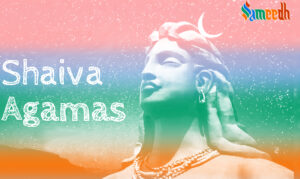The Vijaya Bhairav Agama is a significant scripture in the Shaiva Agama tradition, which is one of the major branches of Hinduism. The Vijaya Bhairav Agama specifically focuses on the worship and rituals associated with Bhairav, who is a fierce form of Lord Shiv. Bhairav is often depicted as having a terrifying appearance, symbolizing the destructive aspect of creation and the ultimate reality beyond dualities.

The Shaiva Agamas are a collection of texts that provide guidelines for rituals, worship, temple construction, and philosophical understanding within the Shaiva tradition, which reveres Lord Shiv as the supreme deity. In the Vijaya Bhairav Agama, one can find detailed descriptions of Bhairav’s iconography, mantras, yantras (sacred diagrams), rituals, and meditation techniques for practitioners. These practices are aimed at invoking the energy and blessings of Bhairav for various purposes such as protection, spiritual advancement, and liberation.
The exact historical origins of the Vijaya Bhairav Agama are not precisely documented, but it is believed to have originated in ancient India, likely several centuries ago. The Shaiva Agama tradition, to which the Vijaya Bhairav Agama belongs, traces its roots back to the early centuries CE.
The Agama texts, including the Vijaya Bhairav Agama, were traditionally passed down orally through lineages of priests and scholars, eventually being committed to writing. These scriptures were preserved and propagated by various Shaiva communities and sects across India, contributing to the rich tapestry of Hindu religious literature.
The Vijaya Bhairav Agama, like other Agama texts, likely underwent revisions and additions over time as it was transmitted orally and eventually written down. It was likely composed by numerous authors and redactors, each contributing to its development and elaboration.
Throughout history, Shaiva communities have revered Bhairav as a significant deity, and texts like the Vijaya Bhairav Agama have played a crucial role in shaping the rituals, worship practices, and philosophical understandings associated with Bhairav worship within the Shaiva tradition.
While specific historical details about the composition and transmission of the Vijaya Bhairav Agama may be unclear, its continued relevance and influence within Shaiva communities attest to its enduring significance as a sacred scripture devoted to the worship of Bhairav.
The Vijaya Bhairav Agama plays several important roles within the Shaiva Agama tradition:
- Guidance for Worship and Rituals: It serves as a comprehensive guide for the worship and rituals associated with Bhairav. This includes detailed instructions on the construction and consecration of Bhairav temples, as well as the performance of various ceremonies and offerings.
- Spiritual Practice: The scripture provides meditation techniques, mantras, and yantras for practitioners to deepen their spiritual practice and connection with Bhairav. These practices are aimed at invoking Bhairav’s energy and blessings for spiritual growth and transformation.
- Protection and Blessings: Devotees turn to the Vijaya Bhairav Agama for protection from negative forces and obstacles on the spiritual path. Bhairav is often revered as a fierce protector who destroys ignorance and grants liberation to his devotees.
- Cultural and Philosophical Significance: As part of the Shaiva Agama tradition, the Vijaya Bhairav Agama contributes to the rich cultural and philosophical heritage of Hinduism. It provides insights into the theological understanding of Bhairav and his role within the Shaiva pantheon.
- Community Practices: The rituals and ceremonies outlined in the Vijaya Bhairav Agama are often performed within the Shaiva community, fostering a sense of unity and devotion among practitioners. These practices help to uphold and preserve the tradition over generations.
Overall, the Vijaya Bhairav Agama serves as a vital scripture within the Shaiva Agama tradition, guiding devotees in their worship, spiritual practice, and understanding of Bhairav’s significance within Hinduism.
